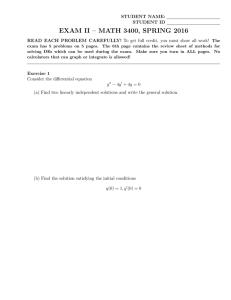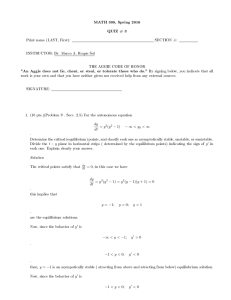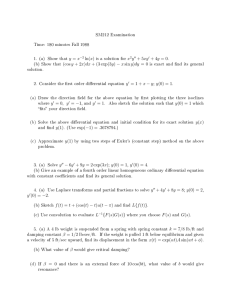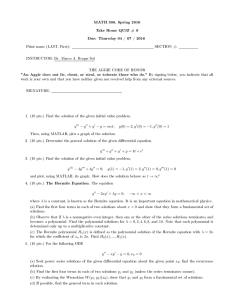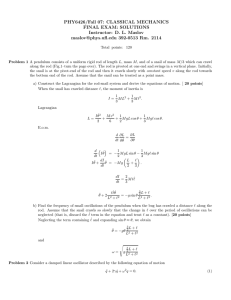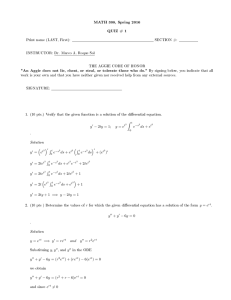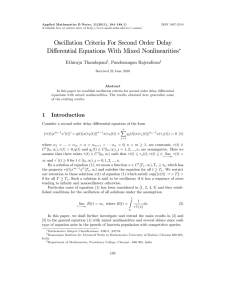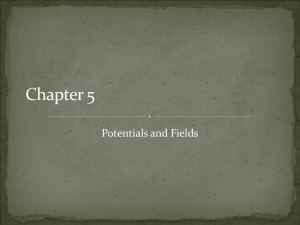Document 10677529
advertisement
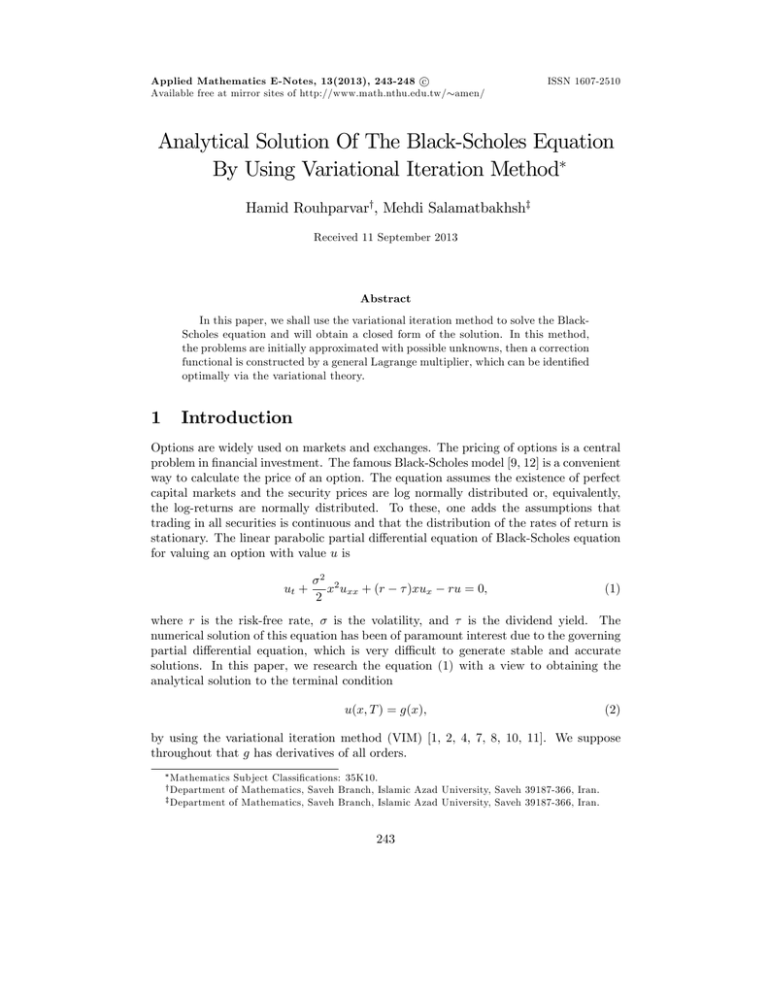
Applied Mathematics E-Notes, 13(2013), 243-248 c Available free at mirror sites of http://www.math.nthu.edu.tw/ amen/ ISSN 1607-2510 Analytical Solution Of The Black-Scholes Equation By Using Variational Iteration Method Hamid Rouhparvary, Mehdi Salamatbakhshz Received 11 September 2013 Abstract In this paper, we shall use the variational iteration method to solve the BlackScholes equation and will obtain a closed form of the solution. In this method, the problems are initially approximated with possible unknowns, then a correction functional is constructed by a general Lagrange multiplier, which can be identi…ed optimally via the variational theory. 1 Introduction Options are widely used on markets and exchanges. The pricing of options is a central problem in …nancial investment. The famous Black-Scholes model [9, 12] is a convenient way to calculate the price of an option. The equation assumes the existence of perfect capital markets and the security prices are log normally distributed or, equivalently, the log-returns are normally distributed. To these, one adds the assumptions that trading in all securities is continuous and that the distribution of the rates of return is stationary. The linear parabolic partial di¤erential equation of Black-Scholes equation for valuing an option with value u is 2 ut + 2 x2 uxx + (r )xux ru = 0; (1) where r is the risk-free rate, is the volatility, and is the dividend yield. The numerical solution of this equation has been of paramount interest due to the governing partial di¤erential equation, which is very di¢ cult to generate stable and accurate solutions. In this paper, we research the equation (1) with a view to obtaining the analytical solution to the terminal condition u(x; T ) = g(x); (2) by using the variational iteration method (VIM) [1, 2, 4, 7, 8, 10, 11]. We suppose throughout that g has derivatives of all orders. Mathematics Subject Classi…cations: 35K10. of Mathematics, Saveh Branch, Islamic Azad University, Saveh 39187-366, Iran. z Department of Mathematics, Saveh Branch, Islamic Azad University, Saveh 39187-366, Iran. y Department 243 244 2 Analytical Solution of the Black-Scholes Equation Variational Iteration Method In this method, the solution of a di¤erential equation with a linearization assumption is used as an initial approximation, then a more precise approximation at some special point can be obtained. To illustrate this method, consider the di¤erential equation in the formal form Lu(x; t) + N u(x; t) = g(x; t); (3) where L is a linear operator, N is a nonlinear operator, and g(x; t) is an inhomogeneous term. According to the VIM, we can construct a correctional functional as Z t un+1 (x; t) = un (x; t) + (Lun (x; s) + N u ~n (x; s) g(x; s)) ds; (4) 0 where is a general Lagrangian multiplier [5, 6], and can be identi…ed optimally via the variational theory, the subscript n denotes the n-th order approximation, u ~n is considered as a restricted variation [5, 6], i.e., u ~n = 0. Eq. (4) is called a correction functional. The successive approximations un+1 , n 0, of the solution u will be readily obtained by suitable choice of trial function u0 . Consequently, the solution is given as u(x; t) = lim un (x; t): n!1 3 (5) Applications In this section, we illustrate the proposed method to Black-Scholes equation. 3.1 Case I According to the VIM, we construct a correction functional for Eq. (1) in the form Z T 2 x2 (~ un )xx + (r )x(~ un )x r(~ un ) ds; (6) un+1 (x; t) = un (x; t) + (un )s + 2 t where is a general Lagrange multiplier, and u ~ denotes the restricted variation, i.e., u ~ = 0. The correction functional (6) Z T 2 x2 (~ un )xx + (r )x(~ un )x r(~ un ) ds un+1 (x; t) = un (x; t) + (un )s + 2 t Z T = un (x; t) + (un )s ds t = un (x; t) un (x; s)js=t Z T 0 t yields the following stationary condition 0 1 (s) = 0; (s)js=t = 0: un (x; s)ds = 0; H. Rouhparvar and M. Salamatbakhsh 245 Therefore, the Lagrange multiplier is (s) = 1: Substituting this value of the Lagrange multiplier into the functional (6) gives the iteration formula Z T 2 x2 (un )xx + (r un+1 (x; t) = un (x; t) + (un )s + )x(un )x r(un ) ds: (7) 2 t We start with an initial approximation: u0 (x; t) = g(x), and using the iteration formula (7), we obtain the following successive approximations u1 (x; t) = g(x) + (T u2 (x; t) t) = g(x) + (T 1 + (T 8 +(4r2 +(4r t) 8r + 4 4 2 2 2 +4 4 g (x) ; 2 00 g (x) 4 2 )xg 0 (x) (4r2 + 4r 2 00 1 )xg 0 (x) + x2 2 rg(x) + x(r t)2 4r2 g(x) 2 1 )xg 0 (x) + x2 2 rg(x) + x(r 8 2 +2 )x3 g (3) (x) + x4 .. . )x2 g 00 (x) i 4 (4) g (x) ; 4 i.e., " 2k ( m n X X X ( 1)(m v) un (x; t) = v!(m v)! m=0 v=0 k=0 where n u(x; t) 2 v 2 k + r (v 1) v ) m (m) x g (x) # t)k (T k! ; 0. Then, the exact solution is given as series = = lim un (x; t) " 2k ( m 1 X X X ( 1)(m v) v!(m v)! m=0 v=0 n!1 2 2 k=0 LEMMA 1. Assume (m 2k X X ( 1)(m v) 'k (x) = v!(m v)! m=0 v=0 v k + r (v 1) v ) m (m) x g # (x) t)k (T k! (8) 2 2 v k + r (v 1) v ) xm g (m) (x): The de…ned function 'k (x) satis…es the recursion 2 2 x2 '00k (x) + (r )x'0k (x) : r'k (x) = 'k+1 (x) for all k 2 N0 : (9) 246 Analytical Solution of the Black-Scholes Equation PROOF. See [Lemma 3.1, 3]. THEOREM 1. The function u(x; t) de…ned by 1 X u(x; t) = 'k (x) t)k (T k! k=0 ; (10) satis…es equation (1). PROOF. Substituting u(x; t) into the equation (1) gives 2 ut + = 1 X (r k=0 1 X = k=1 1 X = = x2 uxx + (r 'k (x) k=0 1 X + 2 k=1 1 X 3.2 0: t)(k k! )x'0k (x) 'k (x) 'k (x) 'k (x) k=1 = k(T )xux ru 1) + 1 X k=0 t)k (T k! 2 2 1 X x2 '00k (x) r'k (x) k! t)k (T k! k=0 1 t)k (T (T t)(k 1) X 2 2 00 + ( x 'k (x) + (r (k 1)! 2 (T t)(k 1) + (k 1)! (T t)(k 1) + (k 1)! k=0 1 X k=0 1 X 'k+1 (x) 'k (x) k=1 )x'0k (x) r'k (x)) t)k (T k! t)k (T k! (T t)(k 1) (k 1)! Case II According to the VIM, we construct a correction functional for Eq. (1) in the following form Z T 2 un+1 (x; t) = un (x; t) + (un )s run + x2 (~ un )xx + (r )x(~ un )x ds: (11) 2 t The correction functional for (11) is Z T un+1 (x; t) = un (x; t) + (un )s 2 run + 2 t = un (x; t) + Z un (x; t) )x(~ un )x ds T ((un )s t = x2 (~ un )xx + (r un (x; s)js=t run ) ds Z t T 0 (s) r (s) un (x; s)ds = 0; H. Rouhparvar and M. Salamatbakhsh 247 which yields the following stationary condition 0 (s) + r (s) 1 (s)js=t = 0; = 0: Hence, the Lagrange multiplier is (s) = er(s t) : Substituting this value of the Lagrange multiplier into the functional (11) gives the iteration formula Z T 2 x2 (un )xx + (r )x(un )x r(un ) ds: un+1 (x; t) = un (x; t) + er(s t) (un )s + 2 t (12) We start with an initial approximation: u0 (x; t) = g(x), and using the iteration formula (12), we obtain the following successive approximations 1 u1 (x; t) = g(x) + (er(T r u2 (x; t) t) 1) 2 r = g(x) 1 er(T t) 1 + r(T 2 )xg 02 rg(x) + x(r + 1 )xg 0 (x) + x2 2 rg(x) + x(r 2 2 t)er(T +(4r 8r + 4 2 4 2 2 +4 + 4r 2 4 3 (3) )x g g (x) ; t) g 00 (x) 1 1 er(T t) + r(T t)er(T 4r2 [4r2 g(x) (4r2 4 2 )xg 0 (x) +(4r2 2 00 8 2 t) +2 (x) + x 4 )x2 g 00 (x) 4 4 (4) g (x)]; .. . where un (x; t) is an approximation of the solution. In fact, the cases I and II show ‡exibility of the VIM method where it can be used in solving the di¤erential equations. 4 Conclusions In this work, the VIM is applied to obtain the solution of Black-Scholes equation in two cases. A theoretical analysis and closed form of the solution was presented for the Black-Scholes equation. The results clearly indicate the reliability and accuracy of the proposed technique. Acknowledgement. The authors would like to thank anonymous referees for their helpful comments. 248 Analytical Solution of the Black-Scholes Equation References [1] H. A. Abdusalam, Analytic and approximate solutions for Nagumo telegraph reaction di¤usion equation, Appl. Math. Comput., 157(2004), 515–522. [2] E. Ahmed and S. Z. Hassan, On di¤usion and some biological economic systems, Z. Naturforsch, 55a(2000), 669. [3] M. Bohner and Y. Zheng, On analytical solutions of the Black-Scholes equation, Appl. Math. Lett., 22(2009), 309–313. [4] J. H. He, Variational iteration method for delay di¤erential equations, Commun. Nonlinear Sci. Numer. Simul., 2(1997), 235–236. [5] J. H. He, Approximate analytical solution for seepage ‡ow with fractional derivatives in porous media, Comput. Methods Appl. Mech. Engrg., 167(1998), 27–68. [6] J. H. He, Approximate solution of nonlinear di¤erential equations with convolution product nonlinearities, Comput. Methods Appl. Mech. Engrg., 167(1998), 69–73. [7] W. Liu and E. Van Vleck, Turning points and traveling waves in FitzHugh-Nagumo type equations, J. Di¤erential Equations, 225(2006), 381–410. [8] H. Rouhparvar, The variational iteration method for solving Nagumo telegraph equation, Int. J. Industrail Mathematics, 2(2010), 295–304. [9] J. Stamp‡i and G. Victor, The Mathematics of Finance, in: Brooks/Cole Series in Advanced Mathematics, Brooks/Cole, Paci…c Grove, CA, Modeling and Hedging, 2001. [10] R. A. Van Gorder and K. Vajravelu, A variational formulation of the Nagumo reaction-di¤usion equation and the Nagumo telegraph equation, Nonlinear Analysis: Real World Applications, 11(2010), 2957–2962. [11] A. M. Wazwaz, Partial Di¤erential Equations, Methods and Applications, A. A. Balkema Publishers, 2002. [12] P. Wilmott, S. Howison and J. Dewynne, The Mathematics of Financial Derivatives, Cambridge University Press, Cambridge, 1997.

